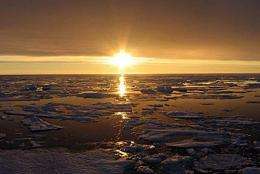First comprehensive geological Arctic map published

Canada has unveiled the first comprehensive Arctic atlas, detailing geological features that point to where oil and gas, gold and diamond deposits are likely hidden beneath snow and ice.
The Geologic Survey of Canada maps contain data collected and compiled over several years by Canada, Russia, the United States, Denmark, Norway, Finland and Sweden at a cost of one billion dollars.
They are expected to help mining and oil and gas exploration companies narrow their searches for resource riches, and may help support several nations' Arctic claims.
"It's the first complete atlas of the polar regions north of 60," Marc St-Onge, a senior scientist at the Geological Survey of Canada, told AFP.
"It could be used for resource exploration or for settling sovereignty disputes in the Arctic," he said.
The main overview map, which breaks down into 1,222 units for greater detail, is now available electronically. High-resolution print versions are to be published next February.
The data contained in them was collected by icebreakers dredging the bottom of the polar sea, flights over the Arctic Circle, seismic profiling, and numerous treks on skis or by dogsled across the frigid Arctic landscape.
The maps highlight continental plates, fault lines, rock types, kimberlite pipes and underwater volcanoes that provide clues to finding the vast oil and gas reserves, and precious metals believed to be hidden there.
They do not reveal unknown deposits, at least not directly.
But by comparing rock ages and types in the Arctic to similar formations elsewhere in the world where oil, gas or metal ore has been found, they may be used to narrow searches for resources.
Bathurst Island in the Canadian Arctic Archipelago, for example, was found to have identical formations to those in Norway where lead and zinc deposits were discovered.
Baffin Bay, west of Greenland, also looks promising for natural gas, said St-Onge.
Until now, each nation published its own geological maps, which often featured different data and classification systems.
"Classic Russian maps show rock age, whereas North American convention is to also show their composition such as limestone or sandstone," St-Onge explained.
Gaps remain, notably under the permanent ice near the pole.
But they are likely to be filled in soon as deadlines loom for nations disputing the sovereignty of the region's waters to complete surveying in order to finalize their claims to overlapping parcels of the Arctic seabed.
Canada, Denmark, Norway, Russia and the United States -- countries that border the Arctic Ocean -- have stepped up Arctic surveying to bolster claims under the United Nations Convention on the Law of the Sea.
The UN treaty stipulates that any coastal state can claim territory 350 nautical miles from their shoreline and exploit the natural resources within that zone.
However, nations must provide scientific proof of the natural extension of continental plates.
"Our atlas shows that the Lomonosov Ridge under the North Pole where Russia planted an undersea flag last year is actually part of the North American plate," said St-Onge.
"It was once part of the Bering Sea platform which in part belongs to Russia, but it separated 61 million years ago and has since moved 900 kilometers (560 miles)," he said.
"More detailed surveying of that area is required, of course, but it looks like it's Canadian."
Interest in the economic exploitation of the Arctic has snowballed in recent years as melting ice floes have increased access to the region.
(c) 2009 AFP
















